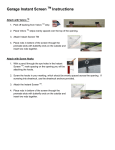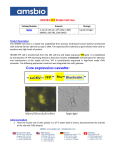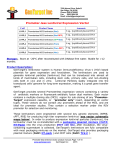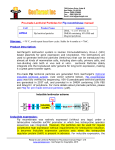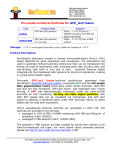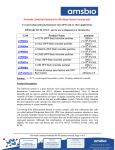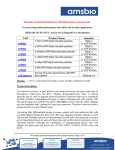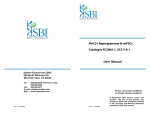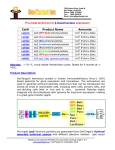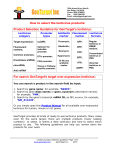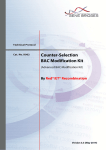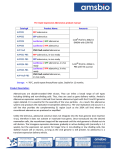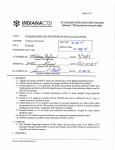Download GenTarget`s EcoTMPlasmid DNA Miniprep Kit User Manual
Transcript
Pre-made Lentiviral Particles for target over expression manual (for human, mouse or rat genes ORFs) Amount: 200ul/vial at > 1 x 107 IFU/ml (or in PBS as special request) Storage: <-70 °C, avoid repeat freeze/thaw cycles. Stable for 6 months at <-70°C. Product Description: Lentiviral system is a gene delivery tool using lentivector for gene expression or knockdown. Lentivector is HIV-1 (Human Immunodeficiency Virus 1) derived plasmids. It produces lentiviral particles (lentivirus) that are capable to transduce into broad range of mammalian cell types or organs, including primary cells and non-dividing cells both in vivo and in cell culture system, and stably integrated into the transduced cell’s genome, independent of cell cycle, for long term expression. Thus lentivirus holds unique promise as gene transfer agents. Pre-made lentiviral particles for specific human or mouse gene are generated from optional inducible lentiviral system (see vector scheme below). Vector has adapted self-inactivation feature in its 3’ LTR, which only generates replication-incompetent particles. Each particle expresses a full sequence verified human, mouse or rat target, matching to CDS sequence of each target according to NCBI accession ID. The human targets were natively expressed under tetracycline inducible suCMV promoter. A blasticidin-RFP fusion dual marker expressed under RSV promoter allows to sort or to select the transduced cells via RFP signal or via blasticidin antibiotic, respectively. RFP signal provides a convenient, real-time monitoring the particles performance. All inducible lentiviral particles can be used for regular constitutive expression. However, when inducible expression is desired, they can optionally be used as tetracycline inducible expression in the presence of a repressor protein (TetR, tetracycline regulator protein). For inducible expression, the target expression is first repressed by TetR, and induced after tetracycline addition. The presence of TetR can be achieved by co-infection of premade TetR lentiviral particles or co-transfected with a TetR expression plasmid, or simply by a tetR expressing stable cell line. Please see our website for more information about the inducible lentiviral system. Amsbio provides the TetR lentiviral particles with different antibiotic selection marker for double selection of the inducible target expression cells. We also provide the Negative control lentivirus for establishing controls for lentivirus treatment in a given cell line, which also validates the specificity of any target expression effects. The control virus to use is: CMV-Null-RB which has the identical lentivector backbone as target expression virus, but does not express any target except the same dual marker. The ready-to-use particles are packaged in 293T cells and provided as 200ul aliquot (Note: the particles can be provided in PBS as special request). Particles are safe and easy to use, simply add into cultured cells or organs. Each particle is validated in lot by lot basis and the target expression is guaranteed. Transduction of pre-made lentiviral particles Lentiviral particles Membrane fusion uncoating Reverse transcription Translation / expression integration Viral RNA Key features: 1. High target expression level driven by strong suCMV promoter; 2. High virus titers that can be readily verified by the RFP fluorescent signal; 3. Optional tetracycline inducible expression when desirable; 4. Easy transduction monitoring via the RFP fluorescent signal under microscope; 5. Dual markers: transduced cells can be sorted via a RFP fluorescent signal or selected via blasticidin antibiotic; 6. The lentivirus is ready and easy to use, simply add into your cell culture. (see transduction carton image above). Note: 1. Depending on your specific needs, you may design the transduction with different MOI for different levels of expression. 2. For some cell lines, you may add polybrene for transduction enhancement. Transduction Protocols: 1. Adhesive cells Transduction Protocols: Note: A quick transduction protocol: add 50ul virus into one well of 24-well-plate when cell density is at 50% - 75%. 72 hours after virus has been added (no need to change medium), visualize the positive cells under fluorescent microscope. For stable cell line generation, pass cells into antibiotic containing medium, or sort the cells via fluorescent signal and then , select the cells by antibiotic. Day 0: Seed the desired cells in complete medium at appropriate density and incubate overnight. (Note: at the time of transduction, cells should be 50% - 75% confluent.) For example, seed HeLa cells at 0.5 x 105/ml x 0.5ml in a well of a 24-well plate; Day 1: Remove the culture medium. Add fresh, warm, complete medium (0.5ml). Thaw the Premade lentiviral stock at room temperature. Add appropriate amount of virus stock to obtain the desired MOI. Return cells to 37°C/CO2 incubator. (Try to avoid thaw / freeze cycles for premade lentivirus. But if you cannot use all virus at once, you still can re-freeze the virus at -80°C for future use. But virus titer will decrease by ~10% for each re-thaw.) Day 3: At ~72hr after transduction, check the transduction rate via fluorescent imaging with a suitable filter under fluorescent microscope, or calculate the exact transduction rate via Flow Cytometry System (FACS) or any flow cytometry (such as Guava machine). Day 3 + (optional): Transduced cells can be sorted via FACS and selected by its specific antibiotic. A pilot experiment should be done to determine the antibiotic’s kill curve for your specific cell line. (Refer to any literature on How to generate stable cell lines.) 2. Suspension cells transduction Protocols: 1. Grow your cell in complete suspension culture medium, shaking flask in CO2 incubator if necessary; 2. Measure cell density. When cell grow to ~3 x 106 cell/ml, measure cell viability (should be > 90%), then dilute cells into 1 x 106 cell/ml in complete medium; 3. Transduction: thaw lentiviral particles at room temperature. Simply add premade lentiviral particle into the diluted cells at ratio of: 50 to 100ul virus per 0.5 ml of cells (Note: depending on the cell type, you may need to use more or less virus). Grow cells in flask, shaking in CO2 incubator. 4. At 24 hours after transduction, add equal amount of fresh medium containing related antibiotic (Note: each particles contain an antibiotic marker and the antibiotic amounts to use depends upon cell types). Grow cell in CO2 incubator. 5. At 72 hours after transduction, check fluorescence under microscope or calculate the transduction efficiency using cell sorting machine (like FACS or Guava machine). 6. You can sort the fluorescent positive cells, and maintain the antibiotic selection to generate stable cell lines. Safety Precaution: Amsbio lentiviral particles have adopted the most advanced lentiviral safety features (using the third generation vectors with self-inactivation SIN-3UTR), and the premade lentivirus is replication incompetent. However, please use extra caution when using lentiviral particles. Use the lentiviral particles in Bio-safety II cabinet. Ware gloves at all times when handling lentiviral particles! Please refer CDC and NIH’s guidelines for more details regarding to safety issues. References: 1. 2. 3. 4. 5. 6. 7. 8. 9. 10. BioTechniques 38:891-894(June 2005); THE JOURNAL OF BIOLOGICAL CHEMISTRY Vol. 279, No. 5, Issue of January 30, pp. 3212–3217, 2004; Biosci. Biotechnol. Biochem., 68(3), 565-5570, 2004; Annu Rev Microbiol. 1994;48:345-69. Microbiol Mol Biol Rev. 2005 Jun;69(2):326-56. APPLIED AND ENVIRONMENTAL MICROBIOLOGY, July 2005, p. 3427–3432; Molecular & Biochemical Parasitology 155 (2007) 167–171; Biosci. Biotechnol. Biochem., 68(3), 565-570, 2004; NIH Guidelines for Biosafety Considerations for Research with Lentiviral Vectors link CDC guidelines for Lab Biosafety levels link Warranty: This product is warranted to meet its quality as described when used accordance with its instructions. Amsbio disclaims any implied warranty of this product for particular application. In no event shall Amsbio be liable for any incidental or consequential damages in connection with the products. Amsbio’s sole remedy for breach of this warranty should be, at Amsbio’s option, to replace the products. Those products are provided for research use only! Related Products: Product Category Fluorescent protein Product Description (please Category name to see product's pages) Premade Lentivirus for GFP/ CFP/ YFP/ RFP Human and mouse ORFs Premade lentivirus expressing human and mouse ORFs with RFP-Blasticidin fusion dual markers. 0TU U0T 0TU U0T CRE recombinase LoxP ColorSwitch TetR inducible expression repressor Premade lentivirus expressing nuclear permeant CRE recombinase with different flurescent and antibiotic markers. Premade lentivirus expressing "LoxP-GFP-Stop-LoxP-RFP" cassette, used to monitor the CRE recombination event in vivo. Premade lentivirus expressing TetR (tetracycline regulator) protein, the repressor protein for the inducible expression system. 0TU U0T 0TU U0T 0TU U0T Premde lentivirus for human and mouse iPS (Myc, NANOG, OCT4, SOX2, FLF4) factors with different fluorescent and antibiotic markers Expression of large and small T antigen with different selection markers iPS factors T-antigen Expression Cell Organelle imaging 0TU U0T Premade lentivirus for cell organelle imaging. The fluorescent marker GFP/RFP/CFP is localized in different cell organelles for live cell imaging. 0TU U0T LacZ expression Fluorescent-ORF fusion Pre-made shRNA lentivirus microRNA and anti-microRNA lentivirus Negative control lentiviruses 0TU Expression of full length β- galactosidase (lacZ) with different selection markers Pre-made lentivirus for expression of "GFP/RFP/CFP-ORF" fusion targets. U0T 0TU U0T 0TU Premade shRNA lentivirus for knockdown of a specific gene (P53, LacZ, Luciferase and more). Premade lentivirus expressing human or mouse precursor miRNA and anti-miRNA lentivector and virus for human and mouse miRNA. U0T 0TU U0T Other Enzyme expression Premade negative control lentivirus with different markers: serves as a negative control of lentivirus treatment, for validation of the specificity of any lentivirus target expression effects. Ready-to-use lentivirus, expressing a specific enzymes with different selection markers.





